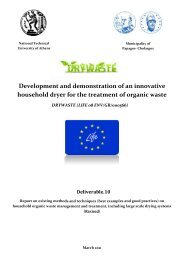MOROCOMP (LIFE TCY05/MA000141) - Unit of Environmental ...
MOROCOMP (LIFE TCY05/MA000141) - Unit of Environmental ...
MOROCOMP (LIFE TCY05/MA000141) - Unit of Environmental ...
You also want an ePaper? Increase the reach of your titles
YUMPU automatically turns print PDFs into web optimized ePapers that Google loves.
Total C (% d.s) 10.5 59.94<br />
Total N (% d.s) 1.76 3.52<br />
C:N ratio 5.97 17.03<br />
Total P, as P 2 O 5 (% d.s) 1.300 0.240<br />
K, as K 2 O (% d.s) 0.691 3.524<br />
Ca as CaO (% <strong>of</strong> d.s) 4.873 3.387<br />
Mg as MgO (% <strong>of</strong> d.s) 2.339 1.381<br />
Cd (mg/Kg d.s) 0.986 0.113<br />
Cr (mg/Kg d.s) 18.410 0.828<br />
Cu (mg/Kg d.s) 141.471 7.924<br />
Ni (mg/Kg d.s) 24.305 0.895<br />
Pb (mg/Kg d.s) 81.094 0.504<br />
Zn (mg/Kg d.s) 237.894 48.916<br />
According to Table 2 the primary sludge acquired increased moisture content <strong>of</strong><br />
72.2% since the collected sludge did not undergo dewatering. On the other hand sugar<br />
beet leaves had much lower water content <strong>of</strong> 48.35%. Sugar beet leaves can balance<br />
the water level <strong>of</strong> the substrate when mixed with primary sludge. The pH <strong>of</strong> primary<br />
sludge and sugar beet leaves was near neutral which is considered satisfactory for the<br />
development <strong>of</strong> composting processes. With respect to the total carbon content sugar<br />
beet leaves acquired high carbon content (59.94%) while in primary sludge the total<br />
carbon was much lesser (10.5%). The nitrogen content was high proportionally to the<br />
carbon content, leading to low carbon to nitrogen ratios <strong>of</strong> 5.97 and 17.03 for the<br />
primary sludge and sugar beet leaves respectively. Furthermore, the physical<br />
properties <strong>of</strong> green waste make a good quality structuring agent for mixing with<br />
sewage sludge. Thus, appropriate blending <strong>of</strong> these materials with the examined<br />
sludge will have C:N and moisture values suitable for the development <strong>of</strong><br />
microorganisms involved in composting.<br />
The quantity <strong>of</strong> nutrients such as nitrogen (N), phosphorous (P), and potassium (K)<br />
incorporated in the raw material, influences the microbial activity during composting<br />
since these nutrients are involved with the protein synthesis <strong>of</strong> the microorganisms to<br />
build cell walls and other structures. In addition N, P and K are used in the greatest<br />
quantities by plans and are the nutrients most <strong>of</strong>ten applied through commercial<br />
30










